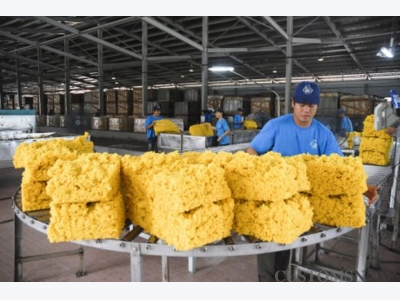Rubber exports increase significant but do not be subjective

After the crisis period 2012-2016, since the second half of 2016, rubber exports have recorded positive signals when the volume as well as export value increased sharply. However, this positive sign was seen unstable, raising the requirement that exporters have to follow the market and have appropriate solutions.
The rubber prices in the future will hardly reach the "bottom" as the previous bleak period.
Supply – Demand is increasingly balancing
The latest report of the General Department of Customs shows that: As of the end of August, the export volume of rubber reached 805.9 thousand tons with the value of $US 1.38 billion, respectively increased by 12.8% in volume and up to 54.2% in value compared to the same period in 2016. Notably, the average export price of rubber in the first eight months also recorded a strong increase by over 36.7% compared to the same period, reached over $US 1,716/ton. China, Malaysia, and India are the three biggest rubber consuming markets of Vietnam in the first eight months, accounting for 63.3%, 6%, and 4.1%, respectively.
After many years of export turnover, especially export price “slope down”, even sometimes hit the bottom, why does the rubber export have a significant “change”?
Talking to Customs reporters, some experts with deep understanding of the rubber industry analysis: the demand of consumption in the global rubber market has increased over the years. In the past, when the rubber industry in the heyday, the price of rubber increased, even rubber is considered as "white gold" to make a great profit making rubber growing rampant. Not only in Vietnam, this situation occurred in many countries which are the main source of rubber for world markets such as Thailand, Indonesia, Cambodia, Laos, China and the Philippines. As a result, the supply increases sharply overcomes the demand significantly that leads to pulling down prices. Rubber enterprises and plantation people are being dashed.
In the period 2012-2016, the rubber industry is constantly in the doldrums. Contrary to the situation of "rubber planters", this period many rubber plantations have been "abandoned" people do not exploit latex. Remarkably, there are rubber areas completely destroyed to replace with other crops. As a result, demand and supply in the rubber market have been balanced, prices have been rising with positive signals.
In the period 2012-2016, the rubber industry is constantly in the doldrums. Contrary to the situation of "rubber plantation in everywhere", this period many rubber plantations have been "abandoned" as the people do not exploit latex. Remarkably, there are rubber areas completely destroyed to replace with other plants. As a result, the demand and supply in the rubber market have been balanced, prices have been rising with positive signs.
From now to the end of 2017 and further, it is predicted that the world rubber market will remain “bright”. However, some enterprises in the rubber industry say that the rubber price can not increase constantly, but it will sometimes increase or fall. The rubber industry's instability is unstable, there may be short-term fluctuations that enterprises need to be active and flexible to deal with.
Strict control the supply
With the current export momentum, it is forecasted that the rubber exports will reach over 1.3 million tons with the value of over $US 2.3 billion this year. The rubber prices in the future will hardly reach the "bottom" as the previous bleak period.
It is easy to see that in the story of the rubber industry, the most important factor is how to control the supply. This is also the problem that the world's leading rubber exporting countries should discuss together.
If the world rubber market is considered a big pie, Vietnam is in the "top" 3 when it occupies over 10% of the market share, Thailand and Indonesia each hold 25-40% of the market share and Malaysia is about 10%, the rest are other countries. Currently, almost all of the above large supply of rubber has declared not or limited to plant new rubber areas in order to avoid the greater supply than the demand, pushing the whole market into difficulties.
Not only that, Thailand, Indonesia, and Malaysia also "join hands" to set up the international tripartite rubber council to better monitor and control the market. Vietnam is also invited to attend this council. According to both the Ministry of Agriculture and Rural Development and the Vietnam Rubber Association, participating in this council will have positive effects on the domestic rubber industry. It is because of the countries which plant and export a large amount of rubber can share, exchange information, see the reality of how the market demands, thereby limiting the production as well as offering flexible solution and dealing with the market fluctuations. However, the current big question that makes Vietnam rubber industry stand outside the Council is the cost of attendance is too high.
When the source of funding from the State budget is still difficult, the rubber enterprises propose that, similar to many other export agricultural products such as pepper, cashew, coffee, the rubber industry wishes to apply the rule that deducts a part of the money from the rubber export fee to raise money for joining the International Tripartite Rubber Council and other activities for the development of the rubber industry sustainability.
Related news
Tools

Phối trộn thức ăn chăn nuôi

Pha dung dịch thủy canh

Định mức cho tôm ăn

Phối trộn phân bón NPK

Xác định tỷ lệ tôm sống

Chuyển đổi đơn vị phân bón

Xác định công suất sục khí

Chuyển đổi đơn vị tôm

Tính diện tích nhà kính

Tính thể tích ao




 Vietnam spends heavily on fertilizer, pesticide imports
Vietnam spends heavily on fertilizer, pesticide imports  Sustainable agriculture development in ASEAN integration
Sustainable agriculture development in ASEAN integration